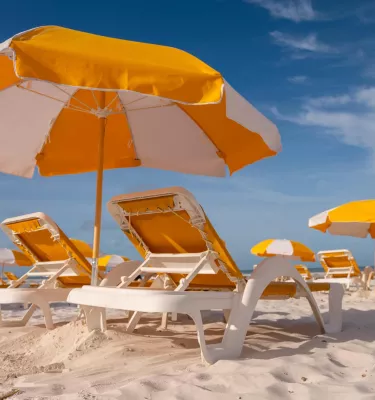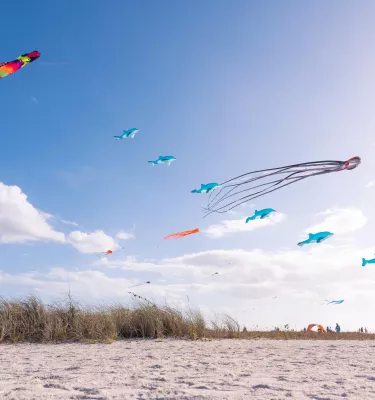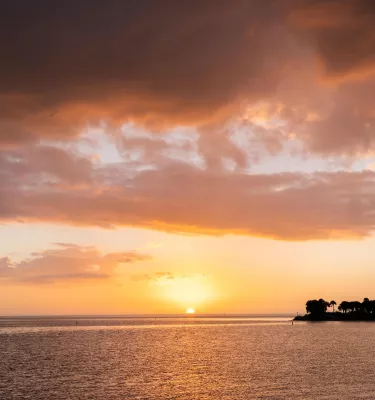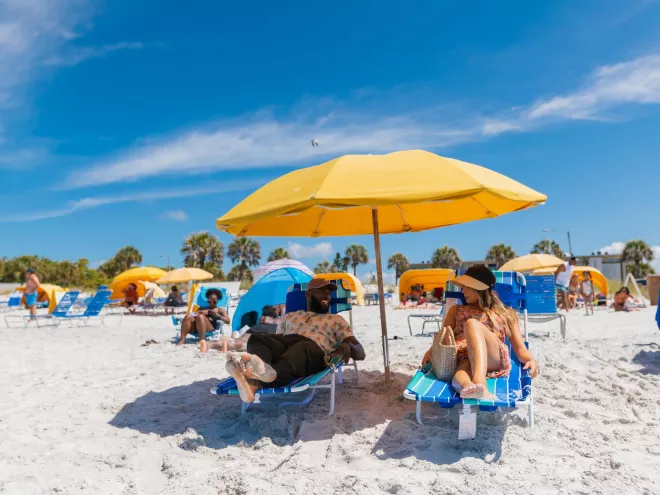Current Beach Updates & Conditions
Learn more about current beach conditions in St. Pete-Clearwater, home to America's Favorite Beaches, in the Tampa Bay area.

Are the beaches open?
All local beaches are open, including Caladesi Island State Park, which reopened on July 3, 2025. However, some boardwalks and access points are still being repaired after two storms affected our area in fall of 2024.
Updated July 3, 2025
Open
- Clearwater Beach: The beach is ready to welcome guests. Pier 60 remains partially closed, but the concession building and its restrooms there are open. Lifeguards are at five towers (three south of Pier 60 and two north of Pier 60). Beach parking is available at the Clearwater Beach Recreation Center parking lot at 69 Bay Esplanade, as well as at the Pier 60 parking lot. The Sunsets at Pier 60 celebration is taking place every evening in the plaza in front of the pier.
- Sand Key Park, just south of Clearwater Beach across the bridge, is open, as is Sand Key Bayside Park.
- Fred Howard Park: The park and beach in Tarpon Springs, north of Clearwater, are open. While the restrooms are being repaired, portable toilets are available.
- Belleair Beach: The Morgan Park beach access at 2650 Gulf Blvd. is open.
- Indian Rocks Beach: The access park between 17th and 18th avenues and its bathrooms have reopened.
- Indian Shores: Beaches are open, including the Tiki Gardens beach access and parking lot, 19601 Gulf Blvd., and access points at 19500 and 19801 Gulf Blvd.
- Redington Shores: Beaches are open. The access point, parking lot and restrooms at 18200 Gulf Blvd. is the primary place to reach the sand. Restoration work at other, smaller access points is ongoing.
- Redington Beach: The public beach access point at 155th Ave. and Gulf Boulevard is open.
- Madeira Beach: The John's Pass Park, parking lot, bathrooms and adjacent beach access are open. Find them at 12774 Gulf Blvd., at the south end of Madeira Beach, directly across Gulf Boulevard from John's Pass Village & Boardwalk. There is another beach access and parking lot open at Gulf Boulevard and 130th Avenue.
- Treasure Island: All Treasure Island beaches are open, including Sunset Beach. Restroom facilities at Gulf Front Park, 10400 Gulf Blvd., are open. Most parking lots, including the one at Sunset Beach, are accessible, and cabana, umbrella and chair rental vendors have resumed operations.
- St. Pete Beach: One of the largest beaches in the area at more than 2 miles long, its beach access points are open at 4700 Gulf Blvd. and at Upham Beach, 6850 Beach Plaza.
- Pass-a-Grille Beach: This beach at the southern end of St. Pete Beach is open, as is its iconic beachfront restaurant, Paradise Grille. Metered parking is available along Gulf Boulevard.
- Fort De Soto Park: The park's beaches are open, including North Beach. Boat ramp access is limited, as repairs are underway.
- Egmont Key State Park: This secluded island, accessible only by ferry or private boats, has reopened.
- Caladesi Island State Park: The park and its pristine beaches reopened on July 3, 2025 after being closed for a number of months. Ferry service to the island has resumed from Honeymoon Island State Park, accessible via the Dunedin Causeway. The Caladesi marina has limited access at this time (10 boats), and overnight accommodations are not available at this time at the marina. Food service may be limited on the island.
Water quality is tested regularly at area beaches. See the latest Florida Healthy Beaches report for Pinellas County.
Partially Open
- Honeymoon Island State Park - Much of Honeymoon Island State Park has reopened, however, some areas and amenities are still closed or under repair. Bathhouses 1 and 2 are closed, but portable toilets are available. Food concessions and beach chair rentals are available in the parking lot east of Bathhouse 1. The Caladesi Ferry is not operating from Honeymoon Island, because Caladesi Island State Park remains closed.
Our Beaches are Pretty as a Picture
America's Favorite Beaches are here to welcome you!


Every night, Sunsets at Pier 60 offers entertainers, vendors and fun for all!
Every night, Sunsets at Pier 60 offers entertainers, vendors and fun for all!


Your chair is waiting for you at the Sandpearl Resort on Clearwater Beach.
Your chair is waiting for you at the Sandpearl Resort on Clearwater Beach.


Visit Sloppy Joe's on the Beach for a casual atmosphere, tasty food and frosty cocktails on Treasure Island!
Visit Sloppy Joe's on the Beach for a casual atmosphere, tasty food and frosty cocktails on Treasure Island!


Fort De Soto Park is one of the most beautiful beaches on the Gulf Coast.
Fort De Soto Park is one of the most beautiful beaches on the Gulf Coast.


Treasure Island's vast expanses of white sand are tailor-made for kite-flying.
Treasure Island's vast expanses of white sand are tailor-made for kite-flying.


Fred Howard Park in Tarpon Springs is a scenic spot that is popular with locals.
Fred Howard Park in Tarpon Springs is a scenic spot that is popular with locals.
Live webcams of our beaches
Take a look at this live beach webcam to see what's happening on Clearwater Beach. And check out our live webcam page for even more views of our beaches.
What's New With St. Pete-Clearwater Beaches
The beaches of St. Pete-Clearwater change each year and every season. Some changes are due to investments to maintain our pristine 35 miles of white-sand beaches, such as renourishment projects that restore and widen the beach to provide more room for fun and to protect coastal wildlife. Beach conditions are also maintained by the tireless efforts of residents and visitors participating in clean up and restoration projects throughout the various St. Pete-Clearwater beach communities.
At times, threats to beach health can include effects of storm surge and coastal flooding as well as red tide, which is a higher-than-normal concentration of algae that is harmful to marine life and causes respiratory irritation for some people.
In addition to these, St. Pete-Clearwater's beaches experience seasonal changes in more subtle ways:
- Turtles nest on our beaches May 1 through October 31. During this time, visitors and resident are strongly encouraged to be extra dedicated to leaving the beach clean and flat, as well as keeping lights dim or off at night to prevent turtle disorientation.
- Gulf water temperatures vary with the seasons. In winter, water temperatures are around 65°- 70°F, while in summer, the water can reach above 85°F. Changes in the temperature can effect the the movement of marine life. For example, the best time to see manatees is between November and April and the best time to fish for tarpon is March to July. Stone crab season starts October 15 and runs through May 1.
- The busiest time of the year to visit the beach is during spring vacation. Beaches tend to be less occupied during fall periods when there are fewer school breaks.
Florida's Beach Warning Flag Program
Many Florida beaches, including beaches in St. Pete-Clearwater, utilize a beach warning flag system to let beachgoers know of current beach conditions. You'll most often see beach warning flags posted on or near lifeguard stands.
Here are the beach warning flag colors and what they mean:
Green Flag: Low hazard, calm conditions.
Yellow Flag: Medium hazard with moderate surf or currents.
Red Flag: High hazard, with high surf or strong currents; when these conditions are present, lifeguards may ask swimmers to get out of the water.
Double Red Flag: Water is closed to the public (you may still walk on the beach, but you may not enter the water).
Blue Flag: Stinging or hazardous marine life such as stingrays or jellyfish are present.
It's important to note that rip currents can occur unexpectedly at any beach. Swimmers should be aware of their surroundings and read about what to do if they get caught in a rip current.
Average Water Temperatures
| January | 64 F | 17.7 C |
| February | 64.4 F | 18 C |
| March | 66.7 F | 19.3 C |
| April | 73 F | 22.8 C |
| May | 78 F | 25.6 C |
| June | 82.4 F | 28 C |
| July | 85 F | 29.6 C |
| August | 86.7 F | 30.4 C |
| September | 84.6 F | 29.2 C |
| October | 81 F | 27.3 C |
| November | 75 F | 23.8 C |
| December | 68.5 F | 20.3 C |
Average Air Temperatures
| Month | High | Low |
| January | 66.7 F /19.3 C | 57 F / 13.7 C |
| February | 68.7 F / 20.4 C | 59 F / 15 C |
| March | 72 F / 22.3 C | 62 F / 16.7 C |
| April | 78 F / 25.4 C | 68 F / 20 C |
| May | 82 F / 27.9 C | 78 F / 25.6 C |
| June | 86 F / 29.9 C | 78.4 F / 25.8 C |
| July | 87 F / 30.7 C | 80 F / 26.6 C |
| August | 88 F / 31 C | 81 F / 27 C |
| September | 87 F / 30.3 C | 78 F / 25.5 C |
| October | 81 F / 27.3 C | 73 F / 22.5 C |
| November | 81 F / 27.3 C | 75 F / 23.9 C |
| December | 71 F / 21.5 C | 61 F / 16.2 C |
Sponsored Content
What's Trending
What's Trending


